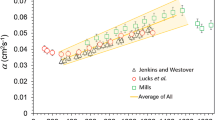Abstract
Copper–chromium–zirconium (CuCrZr) is a commercially available, precipitation-strengthened alloy. The combination of its good thermal conductivity and mechanical strength at low and moderate temperatures made it of interest for use as a heat sink material in high heat flux components in actual and future fusion facilities. Its only drawback is the microstructural modification and thereby, particularly, the loss of mechanical strength at temperatures above 500 °C. This limits the allowable operational temperatures and the temperature range in which cyclic and reproducible measurements of thermophysical properties can be performed. These difficulties and the international significance of the material makes it an excellent object of study for an interlaboratory test of several independent European thermophysical laboratories, in which the quality and the comparability of thermophysical measurements were determined. The main outcome (result, conclusion) of this study is that the different laboratory data are in good agreement providing maximum deviations of ~5 % for dilatometry, ~2 % for DSC measurements, and up to 10 % for thermal-diffusivity measurements. In addition to the determined high reproducibility within the particular thermophysical laboratories, it was found that the average thermal conductivity of CuCrZr produced in a certain compositional range is identical within a small-scatter band.
Similar content being viewed by others
References
ITER Material Properties Handbook, ITER Document No. G 74 MA 9 00-11-10 W 0.1 (2001)
Barabash V., The ITER International Team, Peacock A., Fabritsiev S., Kalinin G., Zinkle S., Rowcliffe A., Rensman J.-W., Tavassoli A.A., Marmy P., Karditsas P.J., Gillemot F., Akiba M., J. Nucl. Mater. 367–370, 21 (2007)
Kalinin G., Barabash V., Cardella A., Dietz J., Ioki K., Matera R., Santoro R.T., Tivey R.: The ITER Home Teams. J. Nucl. Mater. 283–287, 10 (2000)
Tavassoli A.A.F.: J. Nucl. Mater. 258–263, 85 (1998)
Fabritisiev S.A., Zinkle S.J., Singh B.N.: J. Nucl. Mater. 233–237, 127 (1996)
Durocher A., Ayrault D., Chagnot Ch., Lipa M., Saikaly W.: J. Nucl. Mater. 367–370, 1208 (2007)
Lipa M., Durocher A., Tivey R., Huber Th., Schedler B., Weigert J.: Fus. Eng. Des. 75–79, 469 (2005)
Wu X., Pan X., Singh B.N., Li M., Stubbins J.F.: J. Nucl. Mater. 367–370, 984 (2007)
Product brochure, Zollern GmbH & Co. KG, www.zollern.de (2010)
Cowan R.D.: J. Appl. Phys. 34, 926 (1963)
Author information
Authors and Affiliations
Corresponding author
Rights and permissions
About this article
Cite this article
Pintsuk, G., Blumm, J., Hohenauer, W. et al. Interlaboratory Test on Thermophysical Properties of the ITER Grade Heat Sink Material Copper–Chromium–Zirconium. Int J Thermophys 31, 2147–2158 (2010). https://doi.org/10.1007/s10765-010-0857-y
Received:
Accepted:
Published:
Issue Date:
DOI: https://doi.org/10.1007/s10765-010-0857-y




